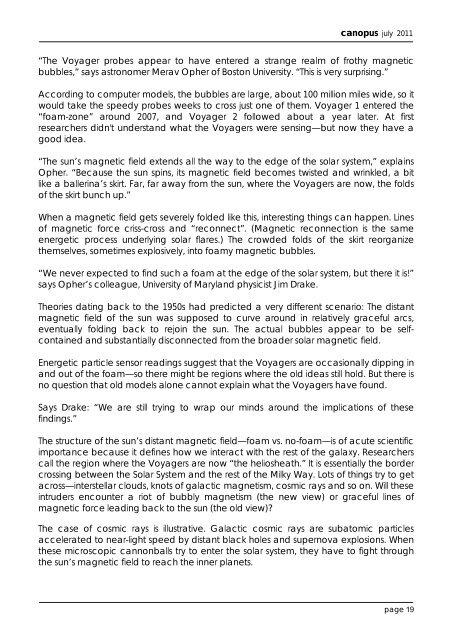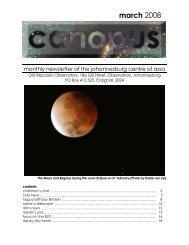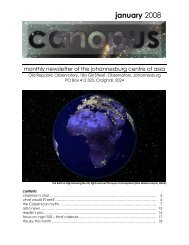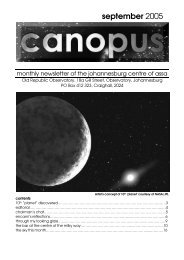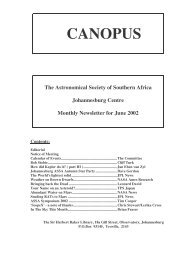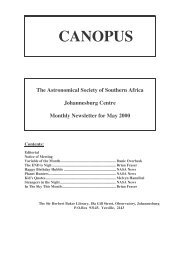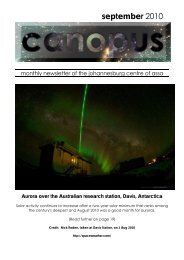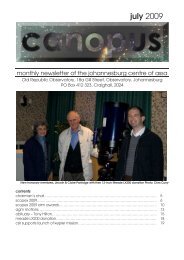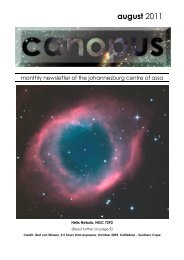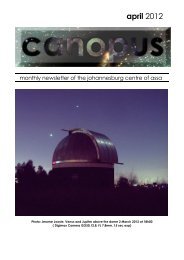july 2011 - Astronomical Society of Southern Africa
july 2011 - Astronomical Society of Southern Africa
july 2011 - Astronomical Society of Southern Africa
You also want an ePaper? Increase the reach of your titles
YUMPU automatically turns print PDFs into web optimized ePapers that Google loves.
canopus <strong>july</strong> <strong>2011</strong><br />
“The Voyager probes appear to have entered a strange realm <strong>of</strong> frothy magnetic<br />
bubbles,” says astronomer Merav Opher <strong>of</strong> Boston University. “This is very surprising.”<br />
According to computer models, the bubbles are large, about 100 million miles wide, so it<br />
would take the speedy probes weeks to cross just one <strong>of</strong> them. Voyager 1 entered the<br />
“foam-zone” around 2007, and Voyager 2 followed about a year later. At first<br />
researchers didn't understand what the Voyagers were sensing—but now they have a<br />
good idea.<br />
“The sun’s magnetic field extends all the way to the edge <strong>of</strong> the solar system,” explains<br />
Opher. “Because the sun spins, its magnetic field becomes twisted and wrinkled, a bit<br />
like a ballerina’s skirt. Far, far away from the sun, where the Voyagers are now, the folds<br />
<strong>of</strong> the skirt bunch up.”<br />
When a magnetic field gets severely folded like this, interesting things can happen. Lines<br />
<strong>of</strong> magnetic force criss-cross and “reconnect”. (Magnetic reconnection is the same<br />
energetic process underlying solar flares.) The crowded folds <strong>of</strong> the skirt reorganize<br />
themselves, sometimes explosively, into foamy magnetic bubbles.<br />
“We never expected to find such a foam at the edge <strong>of</strong> the solar system, but there it is!”<br />
says Opher’s colleague, University <strong>of</strong> Maryland physicist Jim Drake.<br />
Theories dating back to the 1950s had predicted a very different scenario: The distant<br />
magnetic field <strong>of</strong> the sun was supposed to curve around in relatively graceful arcs,<br />
eventually folding back to rejoin the sun. The actual bubbles appear to be selfcontained<br />
and substantially disconnected from the broader solar magnetic field.<br />
Energetic particle sensor readings suggest that the Voyagers are occasionally dipping in<br />
and out <strong>of</strong> the foam—so there might be regions where the old ideas still hold. But there is<br />
no question that old models alone cannot explain what the Voyagers have found.<br />
Says Drake: “We are still trying to wrap our minds around the implications <strong>of</strong> these<br />
findings.”<br />
The structure <strong>of</strong> the sun’s distant magnetic field—foam vs. no-foam—is <strong>of</strong> acute scientific<br />
importance because it defines how we interact with the rest <strong>of</strong> the galaxy. Researchers<br />
call the region where the Voyagers are now “the heliosheath.” It is essentially the border<br />
crossing between the Solar System and the rest <strong>of</strong> the Milky Way. Lots <strong>of</strong> things try to get<br />
across—interstellar clouds, knots <strong>of</strong> galactic magnetism, cosmic rays and so on. Will these<br />
intruders encounter a riot <strong>of</strong> bubbly magnetism (the new view) or graceful lines <strong>of</strong><br />
magnetic force leading back to the sun (the old view)?<br />
The case <strong>of</strong> cosmic rays is illustrative. Galactic cosmic rays are subatomic particles<br />
accelerated to near-light speed by distant black holes and supernova explosions. When<br />
these microscopic cannonballs try to enter the solar system, they have to fight through<br />
the sun’s magnetic field to reach the inner planets.<br />
page 19


